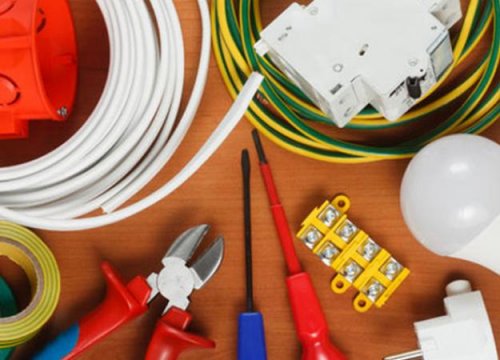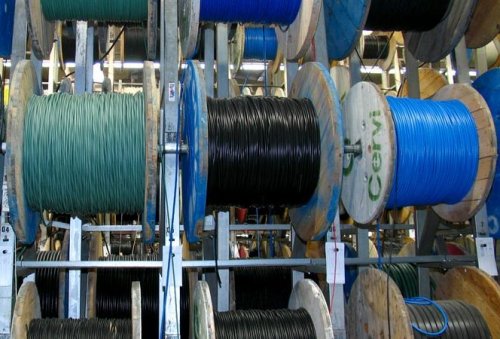Material and technical preparation for production of electrical works
Proper production preparation in many ways contributes to reducing installation time, reducing labor costs and improving the quality of electrical work. Preparation of production in large companies is carried out by specialized departments, in small organizations often one person performs the functions of preparation for production. In electrical installation practice, there are three main areas of preparation for production: engineering-technical, organizational and material-technical.
The engineering and technical training consists of prospective and current preparation of the production, includes questions of the financial assessment of the project, analysis of the adopted project decisions, sufficient completeness of the project and accounting documentation, the degree of compliance of the project decisions with the requirements of the current normative documents, design standards or standard (reusable) designs.This work is typically performed by the Production and Technical (PTO), Capital Construction (OKS), and Estimating and Contracting departments.
Organizational training covers the acceptance of sites for installation, the organization of work performance, control over the installation of built-in parts and the performance of work by related organizations, recruitment of crew, measures to ensure the safety of the facility and a number of other issues. Organizational preparation is usually carried out from the production site.
Material and technical training includes work on the provision of equipment, materials, electrical structures and details for electrical installation parts (MES) workshops, mechanisms, fixtures and tools. At this stage, the supply department works.
In this article, we will consider in detail the features of material and technical preparation for the production of electrical works.
The organizational work of the site cannot produce high-quality results without good material and technical preparation. In order to account for the consumption of materials before starting work, a site boundary fence map (form M-8) is drawn up in duplicate based on the project. One copy is transferred to the site, the second to the warehouse or procurement department.
The purchase of materials for this site and the release of materials for production is carried out by the supply department and the warehouse on its basis. The map of the limit fence is the basis for writing off tangible assets from the warehouse of the materially responsible person in the facility.Materials are written off by the financially responsible person on the basis of signed acts of filling (form KS-2) or on the basis of documented transfer of materials back to the warehouse or to another place.
Today, organizations, depending on the dispersion of objects, the size of the enterprise itself and the structural organization, use one of three forms of organizing the supply of objects: centralized, decentralized and combined.
The centralized form is characterized by the delivery of objects directly from the central warehouse, i.e. purchases of materials on demand are made to the central warehouse, and from there on demand they are sent to the facilities. This method of delivery provides a clear control over the consumption of materials, but increases the organization's costs of storing and transporting materials. Usually, this method is used by large enterprises that have their own warehouses and a fleet of vehicles sufficient to deliver materials to facilities.
Small businesses use the opposite, decentralized form of supply. This form is characterized by the delivery of materials directly to the site, does not require a fleet of vehicles and warehouses, but complicates the control over the consumption of materials, and the materials themselves, which are located at the site, are less protected and are more likely to be damaged and stolen.
The combination of the two described forms gives a compound form. It is suitable for medium enterprises. At the same time, small supplies of materials are immediately sent to the site, and large-volume purchases are stored in the central warehouse and sent to the site in parts, if necessary.
Very often, downtime in facilities is associated with a banal lack of fasteners, consumables for tools and similar trifles.Even if there is an opportunity to buy it in the market, it usually takes half a working day. To prevent such interruptions, electricians create non-reducing stocks in warehouses for frequently used materials. The volume and scope of materials in the non-reducible stock are determined in accordance with the volume and specifics of the company's work.
From fasteners in irreducible stock, they usually hold 3.2×35 self-tapping screws with large threads, 6×50 self-tapping screws for grouse, metal self-tapping screws with a press washer, drill 4.2×19, 4.2×25, dowel 6×40, studded polypropylene (blue), dowel 10×60, cable connection (PVC bracket) 4.5×120, when working with assembly guns — cartridges and dowels.
Of the consumables for the tool, usually in permanent stock, they hold cutting discs for metal 230×2.5×32, 125×22.2×1.0, diamond discs for reinforced concrete for wall partition, SD-plus concrete drills of diameter 6 and 10, drills for concrete SD-max with a diameter of 25 and 32, impact drills for concrete with a diameter of 60, plasterboard bits with a diameter of 60, electrodes.
Of the available materials, they hold: wire PV1 1×1.5, PV1 1×2.5, PVZ 1×1.5, PVZ 1×2.5, cable VVGng-LS 3×1.5, cable VVGng-LS 3×2.5, cable VVGng-LS 5×1 . 5, VVGng-LS 5×2.5 cable, 20 mm diameter corrugated and rigid PVC pipes, 20 mm diameter pipe clamps, junction and mounting boxes, switches, sockets, bulbs, electrical tape, terminal blocks, DIN rail, circuit breakers 16A, 25A, 32A single-phase and three-phase, solder, shrink tubes, metal strip 40x4, metal corner 50x50, Kuzbass varnish.


